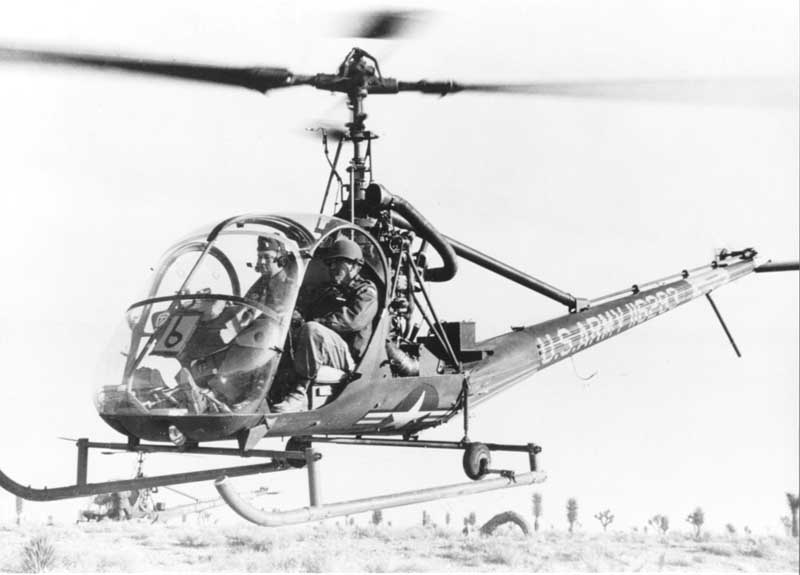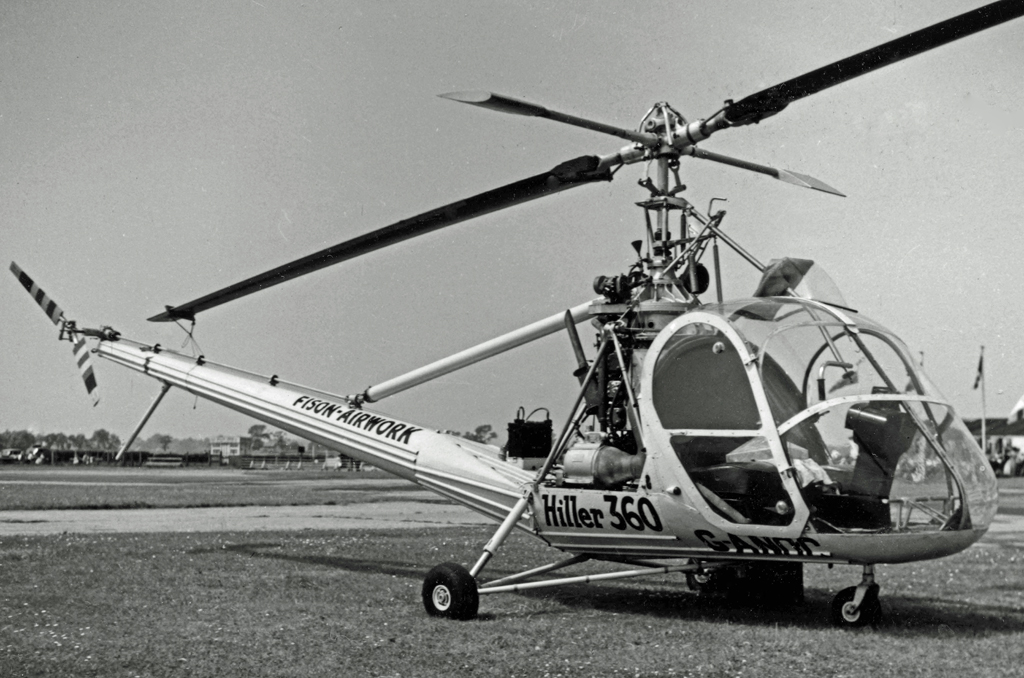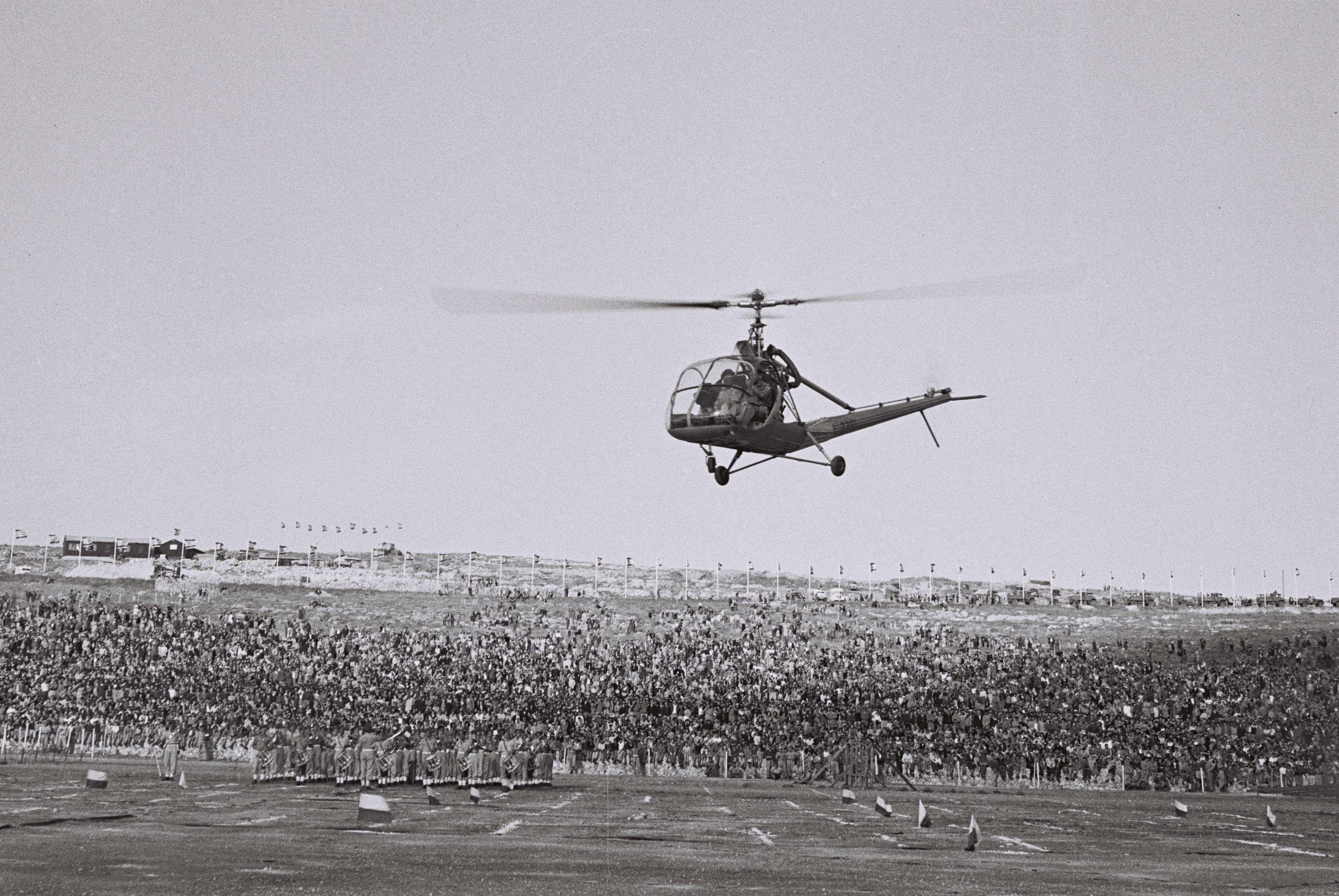OH-23 on:
[Wikipedia]
[Google]
[Amazon]
The Hiller OH-23 Raven is a three-place, military light observation helicopter based on the Hiller Model 360. The Model 360 was designated by the company as the UH-12 ("UH" for United Helicopters),Donald, David. ''The Complete Encyclopedia of World Aircraft''. New York: Barnes & Noble Books, 1998. which was first flown in 1948.



 ;UH-12-E4
:Four-seat civilian version. United States Army designation H-23F. VO-540 powered. Conversion kit available for E-12 models.
;UH-12E-4T
:Four-seat turbine-powered production version.
;UH-12L-4
:Lengthened version with wider cabin windows.
;UH-12-E4
:Four-seat civilian version. United States Army designation H-23F. VO-540 powered. Conversion kit available for E-12 models.
;UH-12E-4T
:Four-seat turbine-powered production version.
;UH-12L-4
:Lengthened version with wider cabin windows.
 * Israeli Air Force
;
* Mexican Air Force
;
*
* Israeli Air Force
;
* Mexican Air Force
;
*

OH-23 Factsheet
Hiller Helicopters on Helicopter History Site
Hiller Helicopter Owners and Pilots Forum
UH-12 & Stanley Hiller at United Helicopter's site
{{Thai helicopter designations Hiller aircraft, OH-23 1940s United States helicopters Hiller OH-23 Raven H-23, Hiller Single-engined piston helicopters Aircraft first flown in 1948
Development
In 1947, United Helicopters (later renamed Hiller Aircraft) developed the prototype Model 360X helicopter. A year later, on 14 October 1948 the Civil Aeronautics Authority (CAA) issued a production certificate for the Model 360. United Helicopters began producing the Model 360 as the UH-12. In 1949, the UH-12 became the first helicopter to make a transcontinental flight from California to New York. When Hiller upgraded the engine and the rotor blades, the company designated the new model as the UH-12A. It was the UH-12A that would be adopted by both the French and United States militaries, as well as being used by civil commercial operators in several countries.Operational history
The H-23 Raven performed as a utility, observation, and MedEvac helicopter during the Korean War. Model numbers ranged A through D, F and G. The H-23A had a sloping front windshield. The H-23B was used as a primary helicopter trainer. Beginning with the UH-23C, all later models featured the "Goldfish bowl" canopy similar to the Bell 47. The Raven used Hiller's "Rotor-Matic" cyclic control system, with two small servo rotor paddles offset 90 degrees to the main rotor blades. The paddles were attached to the control column, so that movement of the column would cause the pitch of the servo paddles to change, loading the main rotor blade so that the desired cyclic changes to the rotor occurred.Bridgman 1953, pp. 240–241. The OH-23 had a top speed of . The Raven had a two-bladed main rotor, a metal two-bladed tail rotor. Both the OH-23B and the OH-23C were powered by one Franklin O-335-5D engine. The OH-23D was a purely military version with a Lycoming O-435-23C engine and a more reliable transmission. Most OH-23Ds were replaced by the OH-23G, the most common version of the Raven, with a more powerful Lycoming O-540-9A six-cylinder, horizontally opposed, air-cooled engine. The OH-23G could seat three. The MEDEVAC version carried two external skid-mounted litters or pods. The Raven saw service as a scout during the early part of the Vietnam War before being replaced by the Hughes OH-6A Cayuse in early 1968. A Raven piloted byHugh Thompson, Jr.
Hugh Clowers Thompson Jr. (April 15, 1943 – January 6, 2006) was a United States Army Major, and a former warrant officer in the 123rd Aviation Battalion of the 23rd Infantry Division. He is credited with ending the Mỹ Lai Massacre of the S ...
played a crucial role in curtailing the My Lai Massacre. When a Raven of the 59th Aviation Company strayed north of the Korean DMZ in August 1969 it was shot down and the crew were kept prisoner until released on December 2.
The Raven could be armed with twin M37C .30-caliber machine guns on the XM1 armament subsystem or twin M60C 7.62 mm machine guns on the M2 armament subsystem. The XM76 sighting system was used for aiming the guns.
The Royal Navy's No. 705 Training Squadron used Hiller HTE-2s for several years from 1953 and later operated Hiller 12E's for many further years as its basic helicopter trainer based at RNAS Culdrose located in Cornwall, England.
Variants



Military
;YH-23 :One Model UH-12A, modified with two-seat cabin and 178 hp Franklin engine for U.S. Army evaluation.Harding 1990, p.141. ;H-23A :Initial production version with 178 hp (133 kW) Franklin O-335-4 piston engine and two-seat cockpit, 100 built for the U.S. ArmyHarding 1990, p.142. and 5 for evaluation by the U.S. Air Force.Swanborough and Bowers 1963, p.274. ;H-23B :H-23A with skid/wheel undercarriage and 200 hp (149 kW) O-335-6 engine (some later re-engined with a 250 hp VO-435-23B), re-designated OH-23B in 1962, 273 built for the U.S. Army and 81 for military export. ;H-23C :Model UH-12C with three-seat cabin, one-piece canopy and metal rotor blades, 145 built for the U.S. Army. Re-designated OH-23C in 1962. ;H-23D :H-23C with new rotor, transmission and 250 hp (187 kW) Lycoming VO-435-23B engine, 348 built for U.S. Army. Re-designated OH-23D in 1962. ;H-23E :Model UH-12E, not bought ;H-23F :Model UH-12E-4, four-seat model with 25-inch cabin extension and a 305 hp VO-540-A1B engine, redesignated OH-23F in 1962, 22 built for U.S. Army. ;H-23G :Three-seat dual control version of H-23F, redesignated OH-23G in 1962, 793 built. ;HTE-1 :U.S. Navy version of the Model UH-12A with Franklin O-335 engine, two-seater with dual controls, and wheeled tricycle undercarriage, 17 built.Swanborough and Bowers 1976, p.440. ;HTE-2 :U.S. Navy version of H-23B with Franklin O-335-6 engine, 35 built. ;Hiller HT Mk 1 :Royal Navy designation for 20 former U.S. Navy HTE-2s. ;Hiller HT Mk 2 :UH-12Es for Royal Navy. 21 supplied.Thetford 1978, p.400. ;CH-112 Nomad :Canadian military designation for the UH-12Es.Civilian
;UH-12A :Original production model for the U.S. Army, powered by a six cylinder fan-cooled Franklin 6V4-178-B33 engine with a maximal power of 178hp at 3000 rpm. The main rotor blades (produced by the Parsons Industries Inc.) are of solid wood laminations. The body of the blade is in fact essentially made up of numerous strip and block wooden laminations designed to provide a strong but highly flexible blade. The entire blade surface is covered with fiberglass cloth with the leading edge covered with an additional stainless steel sheet. The tail rotor is of all metal construction. ;UH-12B (HTE-2) :Training version for the U.S. Navy. U.S. Navy designation HTE-2 prior to 1962. ;UH-12C :Three-seat version, equipped with wood rotor blades and one-piece 'goldfish bowl' canopy. U.S. Army designation H-23C. ;UH-12D :Improved version of the H-23C for the U.S. Army. U.S. Army designation H-23D. ;UH-12E :Three-seat dual-control version of the H-23D. ;UH-12ET :Turbine-powered version of the UH-12E, fitted with an Allison 250 turboshaft engine. ;UH-12E-3 :New three-seat production version. ;UH-12E-3T :New turbine-powered production version. ;UH-12-E4
:Four-seat civilian version. United States Army designation H-23F. VO-540 powered. Conversion kit available for E-12 models.
;UH-12E-4T
:Four-seat turbine-powered production version.
;UH-12L-4
:Lengthened version with wider cabin windows.
;UH-12-E4
:Four-seat civilian version. United States Army designation H-23F. VO-540 powered. Conversion kit available for E-12 models.
;UH-12E-4T
:Four-seat turbine-powered production version.
;UH-12L-4
:Lengthened version with wider cabin windows.
Operators
; * Argentine Army Aviation * Buenos Aires Provincial Police ; * Bolivian Air Force ; * Canadian Army ; * Chilean Air Force ; * Colombian Air Force ; *Dominican Air Force
The Air Force of the Dominican Republic ( es, Fuerza Aérea de República Dominicana), is one of the three branches of the Armed Forces of the Dominican Republic, together with the Army and the Navy.
History
At the end of the United States ...
;
*French Air Force
The French Air and Space Force (AAE) (french: Armée de l'air et de l'espace, ) is the air and space force of the French Armed Forces. It was the first military aviation force in history, formed in 1909 as the , a service arm of the French Army; ...
;
* Bundesgrenzschutz
Bundesgrenzschutz (BGS; en, Federal Border Guard) is the former name of the German ''Bundespolizei'' (Federal Police). Established on 16 March 1951 as a subordinate agency of the Federal Ministry of the Interior, the BGS originally was primari ...
;
* Guatemalan Air Force
;
* Indonesian Air Force
;
 * Israeli Air Force
;
* Mexican Air Force
;
*
* Israeli Air Force
;
* Mexican Air Force
;
* Royal Netherlands Air Force
, colours =
, colours_label =
, march = ''Parade March of the Royal Netherlands Air Force''
, mascot =
, anniversaries =
, equipment ...
;
* Paraguayan Air Force
;
* Peruvian Air Force
;
* Republic of Korea Army
;
* Royal Thai Police
;
*Bristow Helicopters
Bristow Helicopters Limited is a British civil helicopter operator originally based at Aberdeen Airport, Scotland, which is currently a part of the U.S.-based Bristow Group (, S&P 600 component) which in turn has its corporate headquarters in ...
* Royal Navy
;
*Columbia Helicopters
Columbia Helicopters, Incorporated (CHI) is an aircraft manufacturing and operator company based in Aurora, Oregon, United States. It is known for operating tandem rotor helicopters; in present times, exclusively the Boeing Vertol 107 and Boeing ...
* United States Army
* United States Navy
;
* Uruguayan Air Force
Specifications (H-23D)

See also
References
Bibliography
* Bridgman, Leonard. ''Jane's All the World's Aircraft 1953–54''. London: Sampson Low, Marston & Co. Ltd, 1953. * * Harding, Stephen. ''U.S. Army Aircraft since 1947''. Shrewsbury, UK: Airlife, 1990. * * Spenser, Jay. ''Vertical Challenge: The Hiller Aircraft Story''. AuthorHouse. 2003. * Swanborough, F.G. and Bowers, Peter M. ''United States Military Aircraft since 1909''. London: Putnam, 1963. * Swanborough, Gordon and Bowers, Peter M. ''United States Navy Aircraft since 1911'' (second edition). London: Putnam, 1976. ] * Thetford, Owen. ''British Naval Aircraft since 1912'' (fourth edition). London: Putnam, 1978. *OH-23 Factsheet
External links
Hiller Helicopters on Helicopter History Site
Hiller Helicopter Owners and Pilots Forum
UH-12 & Stanley Hiller at United Helicopter's site
{{Thai helicopter designations Hiller aircraft, OH-23 1940s United States helicopters Hiller OH-23 Raven H-23, Hiller Single-engined piston helicopters Aircraft first flown in 1948